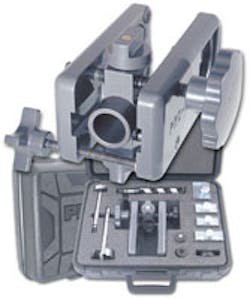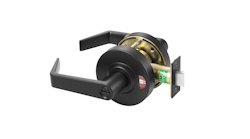When a locksmith is faced with installing a bored lock, one of two conditions exists. Either the lock is a new installation in a blank area of the door, or it is replacing an existing piece of hardware. New holes will need to be drilled in one case and old holes may need to be enlarged or re-aligned in the other.
In either case the use of a quality installation jig makes the job go quicker and results in a more accurate installation. If the existing cross bore and edge bore openings need to be enlarged or re-aligned, making these changes freehand can be extremely difficult.
PRO-LOK has just introduced the Killer Jig, a cylindrical/tubular lock installation tool – part number INJIG-KJ. The 15-piece kit includes four strike-marking tools, a strike locator, a quick-change adapter, two multi-spur bits, an auger bit, four bushing plates and the jig body. (Photo 1)
While it is primarily designed for use on wood doors, the Killer Jig can be used to drill hollow metal doors by using your existing hole saws of the proper size. The little extras like the rubber inserts to prevent marring and quick-change backset adjustment knobs make the tool easy to use and help to project a professional image. Proper use of the protective case will provide protection of the sharpened bits and provide a long lasting addition to your arsenal of tools.
The final component is a fully illustrated 12-page owners’ manual. Clear full color photos are supplemented with helpful information regarding the use and care of the Killer Jig and all of its components. In addition to highlighting the features and benefits, a full step-by-step installation guide is included.
COMPONENTS
Jig Body - The machined aluminum body features hardened bushings, ball bearing adjustment knobs and a durable powder coat finish. Eight holes are milled into the inside face of the jig. These recessed holes contain soft rubber textured pads to protect the finish of the door while preventing slippage. (Photo 2)
Backset Knobs - Two backset alignment knobs contact the leading edge of the door when the jig is slid into position. In one position backset is set at two and three-eighths inches. By turning these knobs 180 degrees, the backset is repositioned at two and three-quarters inches. The knobs contain positive ball bearings and firmly seat into either position through a detent. (Photo 3)
Bushing Plates - Four hardened bushing guide plates are included. For some deadbolts and other locks requiring an 1.5-inch cross bore, one plate is installed on each side of the jig with two screws. For a two and one eighth installation, the smaller bushings are replaced with the larger diameter set. (Photo 4)
Thickness Knobs - To accommodate installations on a wide variety of doors, two door thickness-related adjustment knobs are included on the jig. The smaller star shaped door thickness knob can be pre-adjusted to compensate for thin, standard or thick doors. The large clamping knob is then used to snuggly fit the jig to the door in the drilling position. Both knob screws are cupped into brass bushings to retain proper alignment and minimize wear. (Photo 5)
Quick-Change Adaptor - After the time saving quick-change adapter is installed into your drill chuck, you can instantly switch between the two spur bits and the auger bit. Simply press the spring-loaded release ring to release a bit then snap the alternate bit into place. (Photo 6)
Latch and Strike Markers - The heavy duty latch and strike plate markers are made of solid steel and are used to mark wood doors and frames for mortising the face plates of latches, bolts and strike plates. The four tools included in the kit will fit most standard and heavy-duty commercial knobs, levers and deadbolts including the full lip strikes. (Photo 7)
Strike Locator - The solid aluminum body of the strike locator is fitted with a hardened tip insert that will leave a strike alignment point clearly marked on the frame. (Photo 8)
Drill Bits - Three heavy-duty drill bits are included in the kit. The one-inch auger bit is used to drill the edge-bore hole for most deadbolts and latches on wood doors. The same bit can be used to drill the hole in wood frames to accept the deadbolt or latch. The one and one half inch multi spur bit is used to bore for some deadbolts and the two and one eighth multi spur bit is used for most knobs and levers and some heavy duty commercial deadbolts. (Photo 9, 10, 11)
Carrying Case - The entire range of tools is shipped in a sturdy custom molded carrying case with a polyurafoam interior to protect the contents. Pre-cut areas hold each component in place during transport and keep the tools from contacting one another. (Photo 12)
INSTALLATION PROCEDURE:
Step 1. Select and install the proper size bushing plates and set the backset knob.
Step 2. Place the jig on the door at the desired height.
Step 3. Adjust the door thickness knob to match the door. Use the clamping knob to tighten the jig into position. The jig body must be tight and flush with the face of the door. If the jig is not flat against the face of the door, damage or injury could result. Finally the door thickness knob is checked and adjusted if necessary.
Step 4. Position the quick-change adapter in the drill chuck and tighten.
Step 5. Insert the appropriate multi spur bit to match the cross bore size.
Step 6. Position the multi spur bit in the bushing plate, drilling the hole on the face of the door through to the halfway point. Remove and reposition the bit in the bushing plate on the other side of the door. Drill the hole completely through the door.
Step 7. Release the spur bit from the adapter and replace it with the one-inch auger bit.
Step 8. Drill the one-inch edge bore hole to the proper depth. Remove the bit and remove the jig from the door.
Step 9. Use the correct latch marker to match the lock faceplate. Rap the latch marker with a hammer, then use a sharp chisel to mortise out the wood from the marked area.
Step 10. Insert the strike locator into the latch hole with the sharp point toward the door edge. Close the door tightly and push the strike locator firmly to mark the strike center location.
Step 11. Use the one-inch auger bit to drill the latch/bolt hole to the proper depth.
Step 12. Select the strike marker to match your strike plate, rap with a hammer to mark the outline and chisel out the area indicated.
Step 13. Install the hardware provided by the hardware manufacturer.
For more information on the Killer Jig contact your favorite locksmith distributor or contact PRO-LOK at (714) 633-0681 or at www.pro-lok.com.






